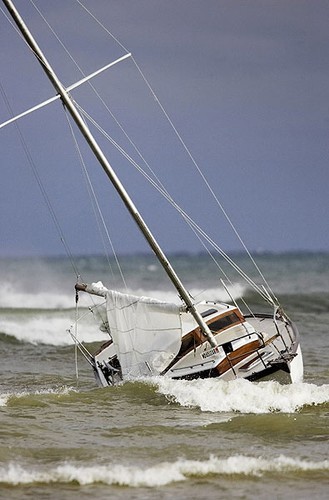Local Pub SOS before Abandoning Yacht
by Nancy Knudsen on 14 Jan 2008

Sometimes they are salvaged many miles from where they are abandoned MIAA
Yet another yacht is afloat in the Atlantic after a British yachtsman was rescued, curiously, by calling his local pub to raise the alarm.
He was in great pain after a fall which caused an apparent broken pelvis, so leaving the yacht was an understandable reaction.
However, it raises again the question of whether one should scuttle a yacht when abandoning it, so that it doesn't become a potential hazard for other vessels.
Alan Thompson fell on the deck of his sailing boat
Padolu which is believed to have broken his pelvis. In severe pain, he managed to reach a satellite phone and for some reason immediately called the Bull's Head pub in Fishbourne, West Sussex. The Falmouth Coastguard were alerted and launched a joint rescue with their American counterparts early on Saturday evening, 600 nautical miles north-east of Bermuda.
Mr Thompson had just bought the 37ft Hunter Legend in Florida and planned to sail it back to the UK single-handed. Two US coastguards were airlifted aboard the sailboat to help him to abandon the uninsured vessel and board a nearby oil tanker.
One can only be glad that Mr Thompson is on his way home. However, with more and more leisure craft taking to the high seas, an increasing number of crews are airlifted or otherwise removed from their boats when tragedy strikes, but leave the boats afloat, sometimes successfully on their own for many months.
Recently, well publicised by the fact that the incident occurred during the Atlantic Rally for Cruisers(ARC), the
Barbary Duck was also abandoned. Reports later said that the boat did become a hazard to other yachts. It was sighted by several boats, and two other boats nearly ran into it, one of them at night.
Yet another boat, the
Compromise, which was in the previous ARC by its crew because of a medical situation on board, travelled through the ocean for about 1,000 miles to the north, finally being salvaged about one mile off the harbour in Horta in the Azores.
Last month an Austrian crew abandoned their yacht
Mary Louise north of Fraser Island on the East Australian coast after an engine failure in treacherous waters and strong winds. A rescue helicopter pulled the three sailors from the 34-foot yacht Mary Louise, and the yacht was abandoned.
Of course it's not new. Recent history is awash (pardon the pun) with stories of similar abandonment. Some of the boats, so abandoned, refused to sink, achieving some remarkable feats.
Yacht Chaton De Foi took just over six months to travel 4,500 miles on its own after being abandoned by owner William Teper during a storm when another boat offered to take Teper on board.. It was finally sighted by fishermen a few miles off the southwestern coast of the Big Island of Hawaii.
Some of the races where crews have abandoned their boats only to have them towed into port later have been famously reported. In this category are the tragic Fastnet Race of 1979, when 24 boats were abandoned by their crews, and 19 of them made it in the sea alone until they were salvaged. In the infamous 1998 Hobart Race, seven boats were also abandoned and then rescued later.
Then there was the 33 ft sailboat called Sara Gamp which travelled 200 miles in the busy ocean off the Massechusetts Coast before it was washed ashore and got itself stuck on some rocks near Yarmouth on Nova Scotia’s south western coast. Its skipper, Vic Gillings, had been rescued by the Coast Guard in a fierce storm, which was too much for the skipper, but obviously not too much for the boat. Later Gillings commented that he wished he hadn’t abandoned her.
Another yacht which travelled successfully on its own after being abandoned was the catamaran Eclipse owned by British yacht designer Richard Woods. Tuna fishermen discovered the abandoned catamaran which had drifted 1000 miles from where it had last been seen. Richard and his crewmember were rescued by a US Navy Warship from the 33ft catamaran off the coast of Mexico after winds reached 52 knots. . By the time the catamaran was found two months later however, she had acquired another crew. Dozens of sea birds had found a sweet resting place in the middle of the ocean.
The stories go on, but there are two issues which arise out of the stories. Should you abandon a yacht which is plainly not holed and still seaworthy? And once you have decided to abandon a yacht, should you skuttle it to prevent it causing harm to other vessels?
It is easy to moralise about the issue from the comfort of a chair by the fire, but faced with such traumatic situations, it is not hard to understand sailors being unable to make the tough decision.
While old seafaring wisdom says you should step upwards to abandon your boat, when the rescue helicopter is hovering overhead, some of your gear is smashed, the storm is not abating and there’s a life waiting for you back home, staying on the boat no doubt becomes a difficult decision.
On the second question, the decision to scuttle a boat and thereby abandon any hope that she just might be able to be salvaged at some future time may be too much to face in the heat of the moment. This is particularly so if, as with many long range cruisers, it is one's only home.
What do you think?
If you want to link to this article then please use this URL: www.sail-world.com/40846